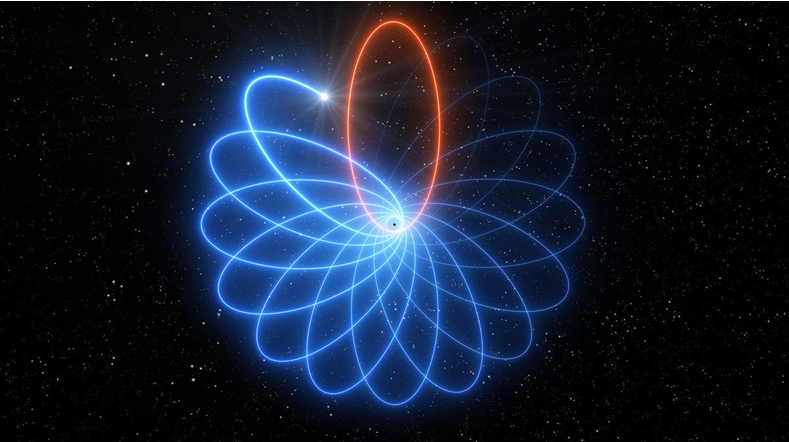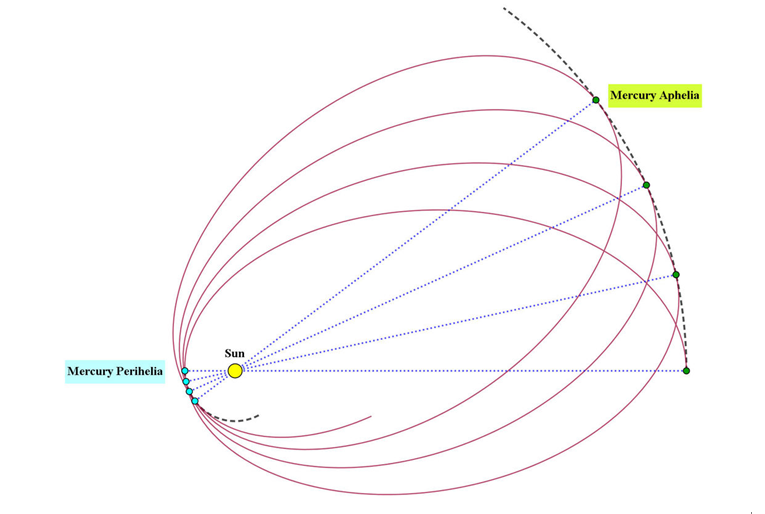
I have some cool news for you here, and it means I get to write this awesome line:
我这里有一些很酷的消息可以和大家分享:
After plunging down to within 18 billion kilometers of the supermassive black hole in the center of our galaxy, a hot star's orbit got dragged into a different configuration due to the black hole's distortion of spacetime around it… just as Einstein predicted.
在位于我们银河系中心的超大质量黑洞覆盖的180亿公里范围内,黑洞对周围空间的扭曲已经影响了恒星的运行轨迹……与爱因斯坦的预测一样。
Heh. That was fun.
哈哈。是不是很有趣。
I've been waiting to hear this news since 2018 (a lot of the back story is in that article, so you should read it). That's when astronomers started prepping to point the Very Large Telescope toward the center of the Milky Way, where a 4 million solar mass black hole sits. Called Sgr A* (literally "Sagittarius A-star"), it's surrounded by a cluster of hot, massive stars that orbit it. One of these stars, called S2, is on a highly elliptical orbit that takes about 15 years to complete.
从2018年起,我就一直在期望听到这个消息。就在那时,天文学家开始将超大望远镜对准了银河系的中心,那里有一个质量是太阳400万倍的黑洞。它被称为Sgr A*(人马座A*),它被一群围绕着它的高密度恒星群所包围。其中有一颗被称为S2的恒星,它的轨道呈椭圆形,大约需要15年才能完成一次轨道运转。

On May 19, 2018, S2's orbit dropped it down to about 18 billion kilometers from the black hole, where the fierce gravity of Sgr A* accelerated it to a staggering 7,700 kilometers per second. That's fast enough to cross the continental United States in less than one tick of a clock's second hand… and mind you, this star has a mass about 10-15 times that of the Sun, too. That's a lot of star moving at tremendous speed.
2018年5月19日,S2的轨道将其抛至距黑洞约180亿公里处,在Sgr A*的强大引力作用下,S2被加速到了每秒7700公里。这颗恒星的质量大约是太阳的10到15倍。其实,很多恒星都会以惊人的速度运动。
Highly-detailed observations of the star before and after passing the black hole confirmed one effect predicted by Einstein's General Theory of Relativity: The light from the star was redshifted, losing energy as it fought its way out of the intense gravitational field of the black hole. It was a big success.
通过对这颗恒星经过黑洞前后状况的详细观察,证实了爱因斯坦广义相对论预测的一种效应:恒星发出的光向红色偏移,它在努力摆脱黑洞的强烈引力时出现了能量流失。这是一个巨大的成功。

But wait! There's more!
但是等等!还有更多消息哦!
Another prediction of relativity is that the orientation of the orbit should change too. Imagine an ellipse representing the stars orbit, with the long axis cutting across the black hole and touching the star at closest approach. That axis points in a certain direction, has a certain angle on the sky, defining the orientation of the orbit. For the Earth orbiting the Sun, say, that direction doesn't change.
相对论的另一个预测是,轨道的方向也应该改变。想象一个椭圆代表恒星的轨道,长轴穿过黑洞,在最接近恒星的地方与恒星接触。这个轴指向一个特定的方向,即在天空中有一个特定的角度,定义了轨道的方向。就像地球绕着太阳转时,这个方向不会变。

But if you orbit a very massive body and get close to it, it will. This is called orbital precession, and one outcome of relativity is that due to the way a massive body distorts spacetime by curving it, an object getting close enough to it will have a measurable precession in its orbit. Mind you, we already knew this is true: Mercury's orbit around the Sun precesses due to this effect, though it's very small.
但如果你围绕着一个非常大的天体运行并接近它时,就会出现所谓的轨道岁差,相对论的一个结论是,由于物体巨大的引力会扭曲时空,所以当一个物体离它足够近的时候,其轨道上就会有一个可测量的岁差。我们当然已经知道这是真的:进动早在水星绕行太阳的轨道中观测到,尽管它非常小。
What astronomers hoped is that their observations pre- and post- closest approach would show this orbital precession for S2… and they did! By carefully measuring the position of the star over time, they found that the orbital precessed by about 1/5th of a degree.
天文学家们希望,通过对S2的轨道进动前和进动后进行的观测,能够发现S2的轨道进动……他们做到了!通过仔细测量这颗恒星的位置随时间的变化,天文学家们发现S2的轨道进动了约1/5度。

It's not a huge change, all things considered, but it's there, and it's measurable, and it’s just what is predicted by the equations of relativity. Astronomers have been tracking this star for many years now, and this is the first time the precession has been seen.
虽然这并不是一个大的变化,但它确实存在,而且可以测量,正如相对论所预测的。天文学家已经跟踪这颗恒星很多年了,但这是第一次观测到岁差。
In the image above the orbit of the star is shown as a solid line (individual observations are the dots), and at the upper left you can see the last orbit doesn't quite overlap the present one. In technical terms we say the orbit isn't closed. Given enough time, say 10 or 20 orbits, you'd be able to see the star tracking a rosette pattern like a flower instead of a single ellipse. That's the precession due to four million Suns worth of black hole warping space around it.
在上图中,这颗恒星的轨道是一条实线(个别的观察结果是圆点),在左上角,你可以看到最后一个轨道和现在的轨道并不完全重叠。从技术上讲,我们说轨道不是闭合的。如果有足够的时间,比如10或20个轨道,你就能看到恒星沿着玫瑰花状的轨迹运行,而不是一个椭圆。这是由于400万个太阳质量的黑洞扭曲了它周围的空间而造成的岁差。

Esoteric? Sure. Weird? Certainly! But important? Absolutely. It shows yet again that Einstein's equations of how spacetime and mass work are right. We know this — that same math is tested a million times every time an accelerator slams subatomic particles together, or even when you use your GPS to get directions — but this is a test under pretty extreme conditions.
深奥吗?确实。奇怪吗?当然!重要吗?绝对的。它再次证明了爱因斯坦关于时空和质量的方程是正确的。我们都知道,在加速器撞击亚原子粒子时,甚至是当你使用GPS导航时,会进行百万次同样的数学运算,但这是一个非常极端条件下的测试。
It also tells us about the environment around the black hole. For example, if there were another object inside S2’s orbit close to Sgr A*, like say another black hole, it would have to have a mass less than 1000 times the Sun’s or else its influence would have been detected in the measurements.
它还告诉我们黑洞周围的环境。例如,如果S2轨道中有另一个物体靠近Sgr A*,就像另一个黑洞,它的质量必须小于太阳质量的1000倍,否则它的影响就会在观测中被发现。
Unfortunately, the 15-year orbital period of S2 means this opportunity doesn’t come up very often. But astronomers just found another star there, called S62, on an elliptical orbit that takes it to a hair-raising distance of just 2.8 billion kilometers from Sgr A* — that's closer than Uranus is to the Sun! Even better, the orbit is just ten years long, so we don't have to wait as long between passes. The problem is the star is much fainter and more difficult to observe, but it's possible (perhaps with James Webb Space Telescope) that future observations of it can get even better numbers.
不幸的是,S2的15年轨道周期意味着这种机会并不经常出现。但是天文学家刚刚在那里发现了另一颗恒星,叫做S62,它的椭圆轨道距离Sgr a *只有28亿公里,这比天王星离太阳的距离还要近!更欣慰的是,这颗恒星的轨道周期只有10年,所以我们不用等太久。问题是,这颗恒星更加暗淡,也更加难以观测,但未来对它的观测可能会得到更好的结果(也许是通过詹姆斯·韦伯太空望远镜)。
It's reassuring to know that Einstein passes even this test. And, in a way, it's reassuring to know that black holes are weird, even in specific and technical ways. Everything about them is so mind-stretching… even in what should be the simple situation of them sitting there while a star orbits around.
得知爱因斯坦通过了这个测试,我感到很欣慰。而且在某种程度上,了解黑洞的怪异会让人安心,即使仅仅是在特定的技术层面上。它们的一切都是如此的令人难以置信,即使是当一颗恒星绕轨道运行时,黑洞也会让简单的情形变得不一样。
原文链接:
https://www.syfy.com/syfywire/einsteins-hand-reaches-out-from-a-black-hole-and-torques-a-stars-orbit
(责任编辑:张钧洋)
(版权说明,转载自:科学猫科普公众号)

